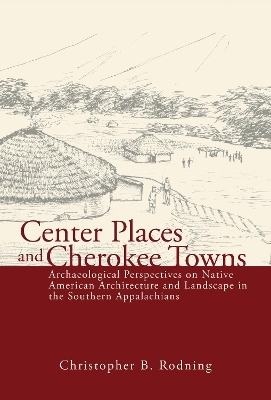
Center Places & Cherokee Towns
Archaeological Perspectives on Native American Architecture & Landscape in the Southern Appalachians
Seiten
2015
The University of Alabama Press (Verlag)
978-0-8173-1841-3 (ISBN)
The University of Alabama Press (Verlag)
978-0-8173-1841-3 (ISBN)
- Titel z.Zt. nicht lieferbar
- Versandkostenfrei innerhalb Deutschlands
- Auch auf Rechnung
- Verfügbarkeit in der Filiale vor Ort prüfen
- Artikel merken
Discusses the ways architecture and other aspects of the built environment, such as hearths, burials, and earthen mounds and embankments, formed centre places within the Cherokee cultural landscape of the southern Appalachians from AD 1400 to 1700. In Center Places and Cherokee Towns, Christopher B. Rodning opens a panoramic vista onto protohistoric Cherokee culture.
In Center Places and Cherokee Towns, Christopher B. Rodning discusses the ways architecture and other aspects of the built environment, such as hearths, burials, and earthen mounds and embankments, formed center places within the Cherokee cultural landscape of the southern Appalachians from A.D. 1400 through 1700.
Archaeology offers a rich framework for understanding a culture before its recorded written history. In Center Places and Cherokee Towns, Christopher B. Rodning opens a panoramic vista onto protohistoric Cherokee culture. He posits that Cherokee households and towns were anchored within their cultural and physical landscapes by built features that acted as “center places.”
Rodning investigates the period from the first Spanish contact with sixteenth-century Native American chiefdoms in La Florida through to the development of formal trade relations between other Native American societies and English and French colonial provinces during the late 1600s and 1700s. Rodning focuses particularly on the Coweeta Creek archaeological site in the upper Tennessee Valley in southwestern North Carolina and describes the ways in which elements of the built environment were manifestations of Cherokee people and culture.
Drawing on archaeological data, delving into primary sources dating from the 1500s through the 1700s, and considering Cherokee myths and legends remembered and recorded during the nineteenth century, Rodning shows how the arrangement of public structures and household dwellings in a Cherokee community both shaped and were shaped by Cherokee culture. The center places Rodning highlights in this rewarding study serve as points of attachment between Cherokee individuals and their communities as well as between their present and past. Rodning explores the ways in which Cherokee architecture and the built environment were sources of cultural stability in the aftermath of European contact, and how the course of European contact altered the landscape of Cherokee towns in the long run.
In this multi-faceted consideration of archaeology, ethnohistory, and recorded oral tradition, Rodning adeptly demonstrates the distinct ways that Cherokee identity was constructed through architecture and other material forms. Center Places and Cherokee Towns will have a broad appeal to students and scholars of southeastern archaeology, anthropology, Native American studies, prehistoric and protohistoric Cherokee culture, landscape archaeology, and ethnohistory.
In Center Places and Cherokee Towns, Christopher B. Rodning discusses the ways architecture and other aspects of the built environment, such as hearths, burials, and earthen mounds and embankments, formed center places within the Cherokee cultural landscape of the southern Appalachians from A.D. 1400 through 1700.
Archaeology offers a rich framework for understanding a culture before its recorded written history. In Center Places and Cherokee Towns, Christopher B. Rodning opens a panoramic vista onto protohistoric Cherokee culture. He posits that Cherokee households and towns were anchored within their cultural and physical landscapes by built features that acted as “center places.”
Rodning investigates the period from the first Spanish contact with sixteenth-century Native American chiefdoms in La Florida through to the development of formal trade relations between other Native American societies and English and French colonial provinces during the late 1600s and 1700s. Rodning focuses particularly on the Coweeta Creek archaeological site in the upper Tennessee Valley in southwestern North Carolina and describes the ways in which elements of the built environment were manifestations of Cherokee people and culture.
Drawing on archaeological data, delving into primary sources dating from the 1500s through the 1700s, and considering Cherokee myths and legends remembered and recorded during the nineteenth century, Rodning shows how the arrangement of public structures and household dwellings in a Cherokee community both shaped and were shaped by Cherokee culture. The center places Rodning highlights in this rewarding study serve as points of attachment between Cherokee individuals and their communities as well as between their present and past. Rodning explores the ways in which Cherokee architecture and the built environment were sources of cultural stability in the aftermath of European contact, and how the course of European contact altered the landscape of Cherokee towns in the long run.
In this multi-faceted consideration of archaeology, ethnohistory, and recorded oral tradition, Rodning adeptly demonstrates the distinct ways that Cherokee identity was constructed through architecture and other material forms. Center Places and Cherokee Towns will have a broad appeal to students and scholars of southeastern archaeology, anthropology, Native American studies, prehistoric and protohistoric Cherokee culture, landscape archaeology, and ethnohistory.
Christopher B. Rodning is an associate professor of anthropology at Tulane University, USA.
| Erscheint lt. Verlag | 30.8.2015 |
|---|---|
| Zusatzinfo | 20 black and white illustrations |
| Verlagsort | Alabama |
| Sprache | englisch |
| Maße | 152 x 229 mm |
| Gewicht | 594 g |
| Themenwelt | Geisteswissenschaften ► Archäologie |
| Geisteswissenschaften ► Geschichte ► Regional- / Ländergeschichte | |
| Sozialwissenschaften ► Ethnologie | |
| Sozialwissenschaften ► Soziologie | |
| ISBN-10 | 0-8173-1841-0 / 0817318410 |
| ISBN-13 | 978-0-8173-1841-3 / 9780817318413 |
| Zustand | Neuware |
| Haben Sie eine Frage zum Produkt? |
Mehr entdecken
aus dem Bereich
aus dem Bereich
Erinnerungen
Buch | Softcover (2024)
Pantheon (Verlag)
16,00 €


